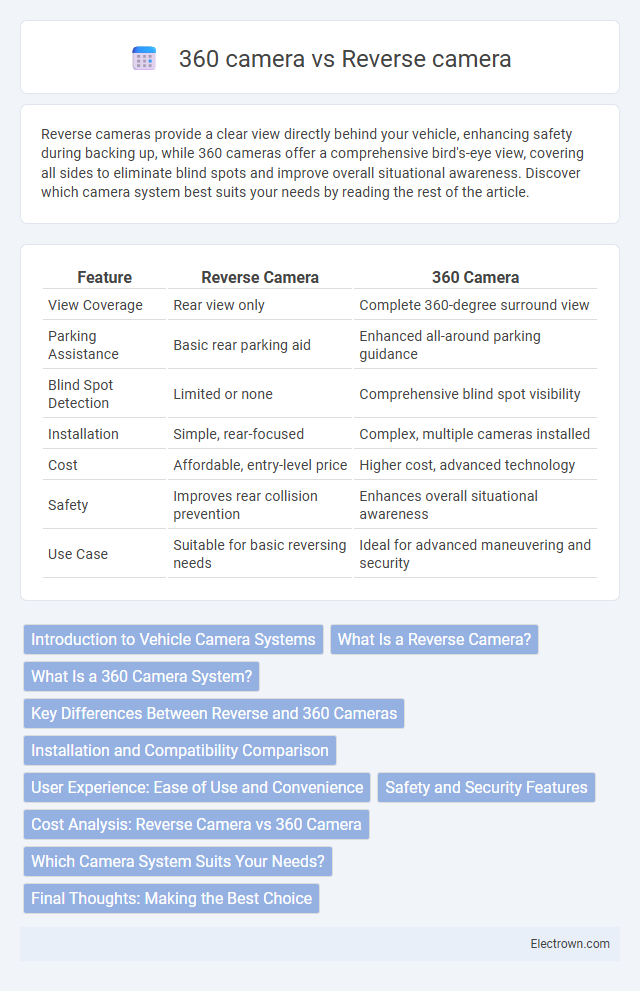Reverse cameras provide a clear view directly behind your vehicle, enhancing safety during backing up, while 360 cameras offer a comprehensive bird's-eye view, covering all sides to eliminate blind spots and improve overall situational awareness. Discover which camera system best suits your needs by reading the rest of the article.
Table of Comparison
| Feature | Reverse Camera | 360 Camera |
|---|---|---|
| View Coverage | Rear view only | Complete 360-degree surround view |
| Parking Assistance | Basic rear parking aid | Enhanced all-around parking guidance |
| Blind Spot Detection | Limited or none | Comprehensive blind spot visibility |
| Installation | Simple, rear-focused | Complex, multiple cameras installed |
| Cost | Affordable, entry-level price | Higher cost, advanced technology |
| Safety | Improves rear collision prevention | Enhances overall situational awareness |
| Use Case | Suitable for basic reversing needs | Ideal for advanced maneuvering and security |
Introduction to Vehicle Camera Systems
Vehicle camera systems have evolved from basic reverse cameras, which provide a single rear view to aid in backing up, to advanced 360-degree cameras offering comprehensive surround visibility. Reverse cameras use a single lens mounted at the rear to assist with parking and obstacle detection, while 360 cameras combine feeds from multiple cameras around the vehicle to create a seamless bird's-eye view. This integration enhances driver awareness, reduces blind spots, and improves safety during low-speed maneuvers.
What Is a Reverse Camera?
A reverse camera, also known as a backup camera, is a vehicle-mounted camera system designed to aid drivers when reversing by providing a live video feed of the area directly behind the car. It enhances safety by reducing blind spots and helping drivers detect obstacles, pedestrians, or other vehicles that may not be visible through mirrors alone. Typically installed near the rear license plate, reverse cameras activate automatically when the vehicle is shifted into reverse gear.
What Is a 360 Camera System?
A 360 camera system integrates multiple wide-angle cameras around your vehicle to provide a comprehensive, bird's-eye view, enhancing situational awareness and safety during parking and tight maneuvers. Unlike a reverse camera that only covers the rear view, a 360 camera system stitches together images to eliminate blind spots and display a seamless surround view on your dashboard screen. This advanced technology significantly reduces the risk of collisions by offering a complete visual perspective in real-time.
Key Differences Between Reverse and 360 Cameras
Reverse cameras provide a rear-view image that enhances safety while backing up by displaying obstacles directly behind your vehicle. In contrast, 360 cameras use multiple lenses to create a comprehensive bird's-eye view, covering all angles around your car for enhanced situational awareness. Your choice depends on whether you need basic rear visibility or a full surround-view system for parking and maneuvering in tight spaces.
Installation and Compatibility Comparison
Reverse cameras typically feature straightforward installation, often integrating directly with your vehicle's existing wiring and display systems, making them widely compatible with most car models. In contrast, 360 cameras require more complex installation due to multiple camera units placed around the vehicle, demanding advanced wiring and software integration, which can limit compatibility to specific vehicles with compatible infotainment systems. Ensuring your vehicle supports the necessary connections and display capabilities is crucial when choosing between reverse and 360 camera systems.
User Experience: Ease of Use and Convenience
Reverse cameras provide a straightforward, single-view display that users can easily interpret when backing up, enhancing basic safety and convenience. 360 cameras offer a comprehensive, bird's-eye view, reducing blind spots and increasing spatial awareness, which significantly improves the overall user experience. Your choice depends on whether you prioritize simplicity and quick feedback or detailed surroundings for maneuvering complex environments.
Safety and Security Features
Reverse cameras enhance safety by providing a clear view of obstacles directly behind the vehicle, reducing blind spots and the risk of collisions while backing up. In contrast, 360 cameras offer a comprehensive, bird's-eye view around the entire vehicle, significantly improving situational awareness and security by detecting pedestrians, vehicles, and potential hazards from multiple angles. Both technologies contribute to accident prevention, but 360 cameras deliver superior coverage for enhanced driver confidence and overall safety.
Cost Analysis: Reverse Camera vs 360 Camera
Reverse cameras typically cost between $50 and $200, making them a budget-friendly option for improving rear visibility. In contrast, 360 cameras range from $200 to $1,000 or more, reflecting their advanced system comprising multiple cameras and sophisticated software for a complete surround view. Installation expenses for 360 cameras are generally higher due to complexity, while reverse cameras often feature easier, DIY-compatible setups.
Which Camera System Suits Your Needs?
A reverse camera offers a clear view directly behind your vehicle, ideal for parking and preventing collisions in tight spaces, while a 360 camera system provides a comprehensive bird's-eye perspective, enhancing overall situational awareness in complex environments. Your choice depends on your driving habits and parking challenges; a reverse camera suits basic rear visibility needs, whereas a 360 camera is perfect for maximizing safety in crowded urban settings or for larger vehicles. Consider your daily driving routes and the level of assistance you require to determine the best camera system for your vehicle.
Final Thoughts: Making the Best Choice
Reverse cameras provide a clear, focused view directly behind the vehicle, ideal for parking and backing up in tight spaces, while 360 cameras offer a comprehensive, bird's-eye perspective enhancing overall spatial awareness and safety. Choosing between these systems depends on driving habits, budget, and the desired level of situational awareness; reverse cameras are cost-effective for precise rear visibility, whereas 360 cameras deliver advanced monitoring covering all angles around the car. For optimal safety and convenience, drivers seeking the most comprehensive protection often prefer a 360 camera system despite higher costs and installation complexity.
Reverse camera vs 360 camera Infographic

 electrown.com
electrown.com